
The Milky Way "Haze" - What Is It?
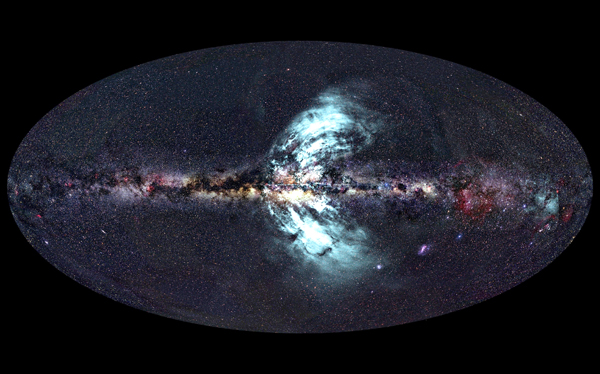
Australia's CSIRO's 64 meter Parkes radio telescope has detected and mapped monster outflows of charged particles from the center of our Milky Way stretching more than halfway across the sky as shown at the left. The outflows of charged particles are not visible to the naked eye. They can only be seen using x-ray or radio telescopes like the Parkes telescope. These outflows contain an extraordinary amount of energy - about a million times the energy of an exploding supernova. However the outflows pose no danger to the earth as they are perpendicular to our rather flat Milky Way Galaxy.
The outflows correspond to a "haze" of microwave emission previously spotted by WMAP and Planck space telescopes. Regions of gamma-ray emission were also detected by NASA's Fermi space telescope in 2010 and were dubbed the "Fermi Bubbles". This page will discuss the discovery of the haze/Fermi Bubbles, various theories about what the source is, and a preliminary conclusion of the current best source hypothesis. Top
Discovering the "Milky Way Haze"
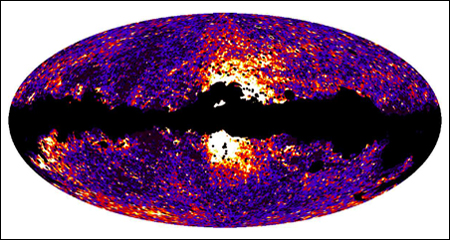
In February 2003, the WMAP (Wilkinson Microwave Anisotropy Probe) team released their first data packet to the public. The main goal of WMAP was to refine the measurements of the CMB (Cosmic Microwave Background) made by its predecessor, the COBE satellite. In order to get at the data from the CMB, the foreground dust had to be removed. At the time most astro-physicists were not interested in the throw away dust, but only the CMB information behind the dust. The CMB is a measure of the original light (now radio microwaves) that is left over from the Big Bang.
However, a bright young Harvard postdoc named Douglas Finkbeiner was interested in the foreground dust as he was studying the microwave emissions from tiny, rapidly rotating grains of interstellar dust. The smallest dust grains can rotate about 20 billion times a second, which translates to a radiation frequency of about 20 GHz. Finkbeiner was about to claim a detection of cosmic "spinning dust", when he also discovered something brand new. He called it the microwave “haze.” The haze had been there in the data all along but was considered to just be cosmic noise that needed to be removed. The WMAP haze is pictured above in cream and red colors in the middle of the map of the universe. The black area in the middle of the map is the extreme light from the center of the Milky Way and associated interplanetary dust (IPD) which overpowers the detail from the satellite picture and has been removed. Top
Early CMB Maps Of The Universe
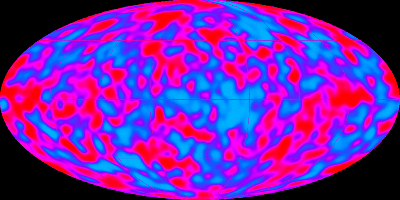
The COBE satellite (operational from 1989 to 1996) did a lot more than just confirm the CMB spectrum which put to bed theories other than the Big Bang. It created the first map of the very early universe (shown at the left) by measuring the small density fluctuations of the CMB using very sensitive microwave radiometers and scanning the whole sky. The CMB density fluctuations are miniscule, on the order of 1 part in 100,000. The original CMB map took two years to compose and became very famous when announced. (It is a standard cosmology technique to show the resultant map in 2 dimensions like the map of the world flattened out at the left below. If you can imagine taking the right and left ends of the map and wrapping them in a circle, you are back to a sphere. This is how maps of the universe are presented.)

The red areas in the COBE map will eventually be empty space while the blue areas will become galaxy clusters. The blue areas are early gravitational fields which are the seeds of clusters of galaxies that will eventually stretch many millions of light years. The light red line across the middle of the map indicates our own Milky Way Galaxy. The COBE CMB map and spectrum was a huge technical support for the Big Bang Theory. The great Steven Hawking called it "the discovery of the century". The CMB measurements by COBE were at the limits of its technology. The map did not answer the many questions cosmologists raised and probably ended up asking more questions than it answered. But... just seeing the earliest viewable universe for the first time was a huge achievement for mankind!
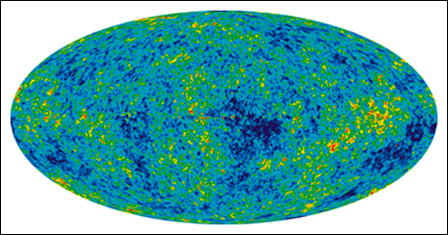
In June 2001, twelve years after COBE, NASA launched a second CMB satellite. Called the WMAP (Wilkinson Microwave Anisotropy Probe, pronounced W-MAP) it was designed to make much more precise measurements of the density variations of the CMB, now called anisotropies (anis-ot'-ropies). Anisotropy is the property of being directionally dependent, as opposed to isotropy, which implies identical properties in all directions. (Wood is an anisotropic material because it is easier to split along its grain than against it.) The result was a much more detailed map (shown at the left) created from seven years of observation data. Note that the colors are reversed from the COBE map, dark blue areas are "cold spots" and the yellow and red areas are hot plasma gases. As one can see, WMAP was significantly more technically sophisticated.
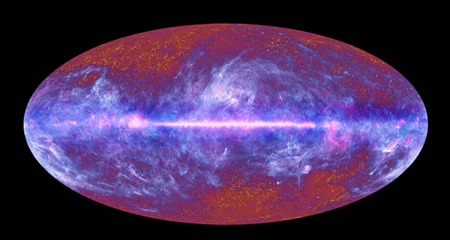
The Planck satellite was launched in May of 2009 by ESA (the European Space Agency). It has extremely sensitive instruments that can map the CMB radiation with great precision. By February 2010 Planck had successfully completed an all sky survey and had started on a second one. Preliminary data from this survey has been released and results indicate that the data quality is excellent.
Planck represents an advance over WMAP in several respects. It has higher resolution by a factor of 3. It has a higher density sensitivity by a factor of 10 and it observes 9 frequency bands rather than 5. The Planck Satellite was able to clearly observe the "haze" radiation from the center of the Milky Way. (The light gray cloudy area just above the center line in the middle of the map.) By using different methods to separate the signal into a very broad range of wavelengths, the Planck team has been able to determine its spectrum. It has not been possible to observe this radiation in such detail before, as previous instruments were not sensitive enough. Top
The Fermi Bubbles
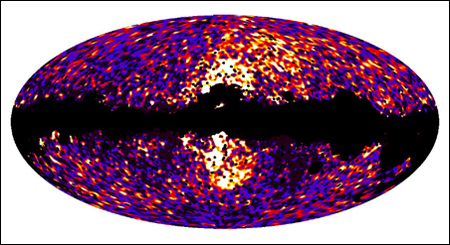
Back to Doug Finkbeiner at Harvard. At the end of summer in 2009 the data from the Fermi Gamma-ray Space Telescope was released to the public. Finkbeiner and his close associates quickly made gamma-ray maps. Buried in the noisy gamma-ray images was the outline of an edge, the edge of a figure-eight, centered on the Galactic Center and extending up and down 50 degrees in latitude, and up to 40 degrees wide. Inspired by the similarity to radio or x-ray bubbles seen in other galaxies, the team named the structure the “Fermi Bubbles” after the Fermi satellite. This raised the possibility that the Fermi Bubbles were emitting most or all of the haze microwaves as well the gamma-rays. The discovery of the gamma-ray structure in addition to the haze pattern has created much interest in the astro-physics community. The exact source of the microwaves and gamma-rays is not known with any certainty so there are quite a few theories being floated about. Top
The Planck Haze
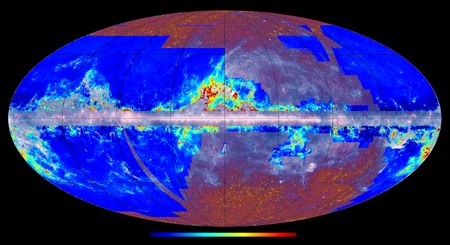
The Planck map at the left shows a haze (gray clouds) and also some strong activity at the center in yellow, red, and light green. ESA (the European Space Agency) has released only preliminary data and unofficial comments about the haze and gamma-ray radiation. ESA has been digesting its data and is due to release it to the public in 2013.
ESA has said "the synchrotron emission associated with the galactic haze exhibits different characteristics from the synchrotron emission seen elsewhere in the Milky Way. The galactic haze shows what astronomers call a “harder” spectrum: its emission does not decline as rapidly with increasing energies."
"The images reveal two exciting aspects of the galaxy in which we live," said Planck scientist Krzysztof M. Gorski from NASA's JPL in Pasadena, CA and Warsaw University in Poland, "They show a haze around the center of the galaxy, and cold gas where we never saw it before." Top
NASA And The Fermi Bubbles
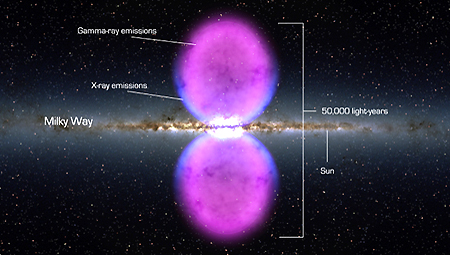
The 2010 NASA illustration at the left shows just how large the Fermi Bubbles are. The Bubbles are enormous - about half the size of our Milky Way, but vertical instead of horizontal. Note the purple outline around the lower edges which are x-ray emissions in addition to the pink gamma-ray emissions. Gamma-rays are the highest energy form of light. Also note that the "figure eight" center is at the supermassive black hole at the center of our galaxy.
"What we see are two gamma-ray-emitting bubbles that extend 25,000 light-years north and south of the galactic center," said Doug Finkbeiner, the astronomer at the Harvard-Smithsonian Center for Astrophysics in Cambridge, Mass., who first recognized the feature. The Fermi LAT (Large Area Telescope) is the most sensitive and highest resolution gamma-ray detector ever launched. Top
Bubbles With Jets

In May of 2012, the Harvard-Smithsonian Center for Astrophysics (CfA) did a press release incorporating the illustration of the Fermi Bubbles with the two jets at the left. The faint jets are an after-image of what existed about a million years ago when our galaxy's supermassive black hole was active. The traces of the two jet beams were recorded in data from NASA's Fermi LAT space telescope. They extend from the galactic center to a distance of 27,000 light-years above and below the galactic plane. They are the first pure gamma-ray jets ever found.
Whereas the bubbles are perpendicular to the galactic plane, the gamma-ray jets are tilted at an angle of 15 degrees. This may reflect the tilt of the accretion disk surrounding the supermassive black hole with respect to the galactic plane.
The two structures were formed differently. The jets were most likely produced when plasma was ejected out from the accretion disk of the black hole, following a corkscrew-like magnetic field that kept it tightly focused. The gamma-ray bubbles more than likely were created by a "wind" of hot matter blowing outward from the black hole. As a result, they are much broader than the narrow jets.
"These jets probably flickered on and off as the supermassive black hole alternately gulped and sipped material," said Doug Finkbeiner. It would take a tremendous influx of matter for the galactic core to fire up again. Finkbeiner estimates that a molecular cloud weighing about 10,000 times as much as the Sun would be required. "Shoving 10,000 suns into the black hole at once would do the trick. Black holes are messy eaters, so some of that material would spew out and power the jets," he said. Top
Are The Bubbles A Milky Way Burp?
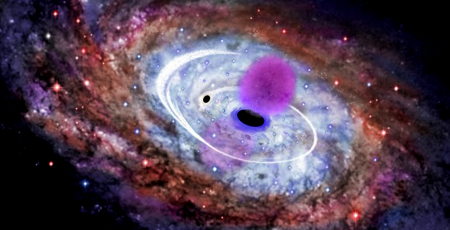
One theory is that the Fermi Bubbles are a shockwave in which high energy electrons interact with photons and give up their energy in the form of gamma rays. However, the shockwave is many times bigger than astronomers would even expect to see from a supernova. Kwong Sang Chen at the University of Hong Kong and associates say the bubbles are the remnants of stars that have been eaten by the supermassive black hole at the center of the galaxy. Our galaxy’s supermassive black hole is some four million times more massive than the sun. Chen and co. assume that a star falls into it every 1000 years or so. When this happens, part of the star is devoured by the black hole, while the rest is burped back out into space in the form of high energy protons.
These protons heat up the gas and dust surrounding the black hole creating an expanding bubble of high energy electrons. This cannot expand far in the plane of the galaxy because it is absorbed. But the electrons can travel far into the space above and below the galactic plane, creating the gamma ray bubbles seen by Fermi. This theory can explain why the edge of the bubble is so well defined. Top
Is The Haze A Dark Matter Signature?
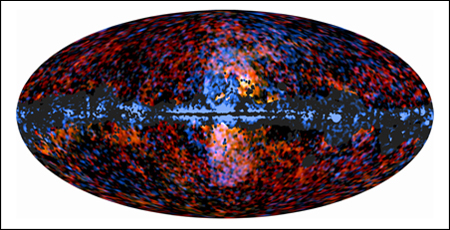
The Planck satellite has extremely sensitive instruments that can map microwave radiation with great precision. By using different methods to separate the signal for a very broad range of wavelengths, the Planck team has been able to determine the spectrum of the radiation. The radiation has a known spectrum which is "synchrotron emission". Synchrotron emission originates from collisions of electrons and positrons circulating at very high speeds around the lines of a magnetic field.
Dark matter may consist of very heavy particles that are around 10 times as heavy as the Higgs particle, that is about 1,000 times heavier than a proton. But, they have very unique properties and do not interact with ‘normal’ matter particles.
Theoretical predictions indicate that the concentration of dark matter particles around the center of a galaxy is very high and that they most likely collide and in the collision process electrons and positrons are formed. These electrons and positrons rotate very fast around the magnetic field and in doing so produce the very characteristic "synchrotron radiation".
“The radiation cannot be explained by the structural mechanisms in the galaxy and it cannot be radiation from supernova explosions. I believe that this could be proof of dark matter. Otherwise, we have discovered an absolutely new and unknown physics mechanism of acceleration of particles in the Galactic Center”, says Pavel Naselsky, professor of cosmology at the Niels Bohr Institute at the University of Copenhagen.
However, simulations suggest that dark matter halos would be roughly spherically symmetric. The haze appears to be more elongated than originally thought, which casts some doubt over claims that annihilating dark matter is the cause of the emissions. At this point dark matter remains a possible source of the haze, but it seems like a long shot. Top
Outflows From Exploding Young Stars
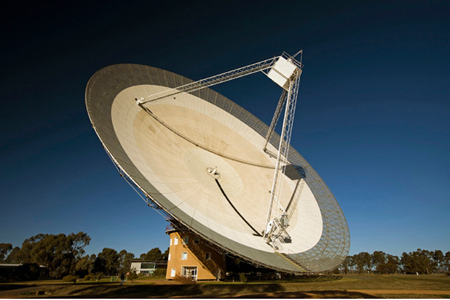
Australia's CSIRO's radio telescope Team, in a press release of January 3, 2013, concluded that the monster outflows of charged particles from the center of our Milky Way appear to have been driven by many generations of stars forming and exploding in the Galactic Center over the last hundred million years. The key was to measure the outflows' magnetic field lines using the Parkes gigantic 64 meter radio telescope (pictured at the left).
Star formation is intense in the center of our galaxy. See the image (at the left below) of the Galactic star forming area taken by the Planck satellite. Many generations of forming stars, lasting just a short time (by cosmic standards), and then exploding as supernovas, have generated the outflows according to the CSIRO Team. The speed of the outflows is supersonic, about 1000 kilometers a second. "That's fast, even for astronomers," CSIRO's team leader, Dr Ettore Carretti said.
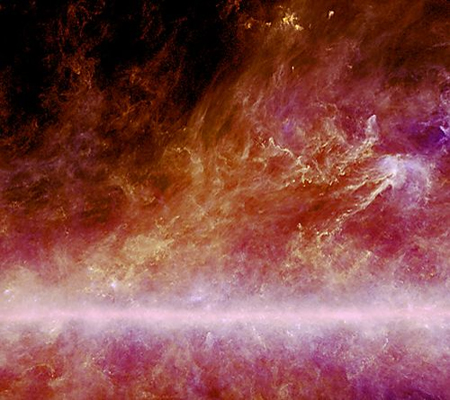
The CSIRO team believes the outflows encompass both the "haze" of microwave emissions previously recorded by the WMAP and Planck space telescopes and also the gamma-ray emissions (the Fermi Bubbles) seen by NASA's Fermi LAT space telescope. "The WMAP, Planck and Fermi observations did not provide enough evidence to definitively identify the source of the radiation they detected, but the new Parkes observations do", says the Team in their press release.
Star formation areas produce a flow of cosmic rays and an outflow of hot, thermal plasma with "frozen" magnetic field lines. These outflows have some huge ridge-like features that are aligned with the magnetic fields with a few of them having their roots in the Galactic Center. These features are not consistent with a Milky Way black hole "burp".

The Bubbles have a "narrow waist" whose diameter happens to correspond to the size of the star-forming gas ring around the center of the galaxy. The Parkes Radio Telescope mapped the radio waves above and below the galactic center (shown at the left below). The "light" dotted lines outline the Fermi Bubbles, the "heavy" lines outline the Parkes outflows. The Parkes map shows that the outflows line up almost perfectly with the gamma rays of the Fermi Bubbles with the top and bottom corners stretching a bit more to the right. The match suggests that whatever is causing one is also causing the other. And the photon spectrum indicated that they were not just any old radio waves, but synchrotron radiation which has a characteristic polarization and suggests strong magnetic fields.
The star-forming area is also "missing" some radio and gamma-ray emissions. Based on the amount of infrared light that is ejected from the area, scientists expected to see a lot more radio and gamma-rays from that region. However, they are not there. The Team thinks that they may have been ejected into the Bubbles. In fact, if they take the Bubble radiation and theoretically return it back into the star-forming region, the total radiation level is then almost exactly what they would have expected to see.
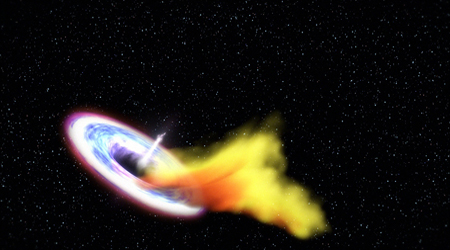
While the CSIRO Team believes that star formation is causing the outflows. The obvious next question is "What has generated the intense star formation area to begin with?". The most likely candidate is a theory put forth by Kelly Holley-Bockelmann at Vanderbilt and Tamara Bogdanovic at Georgia Institute of Technology. They theorize that many eons ago a small Milky Way satellite galaxy began migrating towards the galaxy's central super-massive black hole. As it merged with our galaxy, its mass was torn away, leaving only its black hole and a small collection of gravitationally bound stars. After several million years, the smaller black hole reached the galactic center and the black holes began to merge. As the smaller black hole was swirled around the larger hole, it ejected huge amounts of gas and dust. (See the artists illustration at the left.) The dueling gravitational forces were not gentle. These intense forces were capable of compressing the molecular clouds surrounding the core into the density required to produce fresh, young stars and the star-forming area was born.
The CSIRO Team obviously believes they have the answer to the Haze and Bubble mysteries. However, there are other scientific groups that have proposed somewhat different scenarios. It remains to be seen if the astro-physics community in general concurs with the findings of the CSIRO Team that the star-forming area is the real souce of the Galactic Center Outflows.